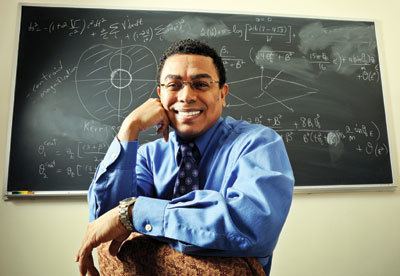Name Arlie Petters Role Physicist | ||
 | ||
Born Arlie Oswald Petters February 8, 1964 (age 61) Stann Creek Town, British Honduras(now Dangriga, Belize) ( 1964-02-08 ) Alma mater City University of New YorkMassachusetts Institute of Technology Doctoral advisors Bertram KostantDavid Spergel Known for Mathematical Theory of Gravitational Lensing Notable awards Alfred P. Sloan FellowshipNSF CAREER AwardBlackwell-Tapia PrizeMost Excellent Order of the British Empire Books Singularity Theory and Gravitational Lensing Education City University of New York, Hunter College, Massachusetts Institute of Technology | ||
Is there a fifth dimension arlie petters at tedxncssm
Arlie Oswald Petters, MBE (born February 8, 1964) is a Belizean-American mathematical physicist, who is the Benjamin Powell Professor of Mathematics and a Professor Physics and Economics at Duke University. Petters is a founder of mathematical astronomy, focusing on problems connected to the interplay of gravity and light and employing tools from astrophysics, cosmology, general relativity, high energy physics, differential geometry, singularities, and probability theory. His monograph "Singularity Theory and Gravitational Lensing" is the first to develop a mathematical theory of gravitational lensing. Petters is also the Dean of Academic Affairs for Trinity College of Arts and Sciences and Associate Vice Provost for Undergraduate Education at Duke University.
Contents
- Is there a fifth dimension arlie petters at tedxncssm
- Arlie petters explains how scientists could demonstrate a fourth dimension of space
- Biography
- Research
- Social Outreach
- Awards and honors
- References

Arlie petters explains how scientists could demonstrate a fourth dimension of space
Biography

Petters was raised by his grandparents in the rural community of Stann Creek Town, British Honduras (now Dangriga, Belize). His mother immigrated to Brooklyn, New York, and married a U.S. citizen, with Arlie joining them when he was 14 years old.
Petters earned a B.A./M.A. in Mathematics and Physics from Hunter College, CUNY in 1986 with a thesis on "The Mathematical Theory of General Relativity", and began his Ph.D. at the Massachusetts Institute of Technology Department of Mathematics in the same year. After two years of doctoral studies, he became an exchange scholar in the Princeton University Department of Physics in absentia from MIT. Petters earned his Ph.D. in Mathematics in 1991 under advisors Bertram Kostant (MIT) and David Spergel (Princeton University). He remained at MIT for two years as an instructor of pure mathematics (1991-1993) and then joined the faculty at Princeton University in the Department of Mathematics. He was an Assistant Professor at Princeton for five years (1993-1998) before moving to Duke University.
Petters's work and life were profiled in the New York Times, on NOVA, by The History Makers, and at Big Think.
Research
Petters is renowned for his pioneering work in the mathematical theory of gravitational lensing.
Over the ten-year period from 1991–2001, Petters systematically developed a mathematical theory of weak-deflection gravitational lensing, beginning with his 1991 MIT Ph.D. thesis on "Singularities in Gravitational Microlensing" and followed by the 12 papers [AP1] - [AP12] below. The papers resolved an array of theoretical problems in weak-deflection gravitational lensing covering image counting, fixed-point images, image magnification, image time delays, local geometry of caustics, global geometry of caustics, wavefronts, caustic surfaces, and caustic surfing. His work culminated with a 2001 mathematical tome [AP13] that, among other things, systematically created a framework of stability and genericity for k-plane gravitational lensing. The book drew upon powerful tools from the theory of singularities and put the subject of weak-deflection k-plane gravitational lensing on a rigorous and unified mathematical foundation.
Following his 1991-2001 body of mathematical lensing work, Petters turned to more astrophysical lensing issues from 2002-2005. In collaboration with astronomers, he applied some of the mathematical theory in [AP13] to help develop a practical diagnostic test for the presence of dark substructures in galaxies lensing quasars; classify the local astrometric (centroid) and photometric curves of an extended source when it crosses fold and cusp caustics due to generic lenses; predict the quantitative astrometric curve's shape produced by Galactic binary lenses. The classified local properties of the astrometric curves revealed a characteristic S-shape for fold crossings, parabolic and swallowtail features for cusp crossings, and a jump discontinuity for crossings over the fold arcs merging into a cusp. A formula for the size of the jump was also found.
During 2005-2007, Petters collaborated with astronomers and physicists to explore gravitational lensing in directions beyond its traditional confines in astronomy. In a series of three mathematical physics papers (2005–2006) with the astronomer Keeton, he utilized higher-order gravitational lensing effects by compact bodies to test different theories of gravity with Einstein's general theory of relativity among them. The first two papers computed beyond the standard weak-deflection limit the first- and second-order corrections to the image positions, magnifications, and time delays due to lensing in general relativity and alternative gravitational theories describable within the PPN formalism, and even determined lensing invariants for the PPN family of models. Their findings were applied to the Galactic black hole, binary pulsars, and gravitational microlensing scenarios to make testable predictions about lensed images and their time delays. The third paper took on the difficult issue of how to test hyperspace models like braneworld gravity that postulate an extra dimension to physical space. The paper developed a semi-classical wave theory of braneworld black hole lensing and used that theory along with braneworld cosmology to predict a testable signature of microscopic braneworld black holes on gamma-ray light. Additionally, in a 2007 paper, Petters and Werner found a system of equations that can be applied to test the Cosmic Censorship Hypothesis observationally using the realistic case of lensing by a Kerr black hole.
Petters's previous work (1991–2007) dealt with non-random gravitational lensing. His recent research program (2008–present) has been to develop a mathematical theory of random (stochastic) gravitational lensing. In two papers, he, Rider, and Teguia took first steps in creating a mathematical theory of stochastic gravitational microlensing. They characterized to several asymptotic orders the probability densities of random time delay functions, lensing maps, and shear maps in stochastic microlensing and determined a Kac-Rice type formula for the global expected number of images due to a general stochastic lens system. The work forms a concrete framework from which extensions to more general random maps can be made. In two additional papers, he and Aazami found geometric universal magnification invariants of higher-order caustics occurring in lensing and caustics produced by generic general maps up to codimension five. The invariants hold with a probability of 1 for random lenses and thereby form important consistency checks for research on random image magnifications of sources near stable caustics.
For more information, consult Petters's official Duke University CV for a very useful road map with detailed and extensive summaries of his research papers.
Selected papers from 1991–2001:
[AP1] "Morse Theory and Gravitational Microlensing," A. O. Petters, J. Math. Phys., 33, 1915 (1992).
[AP2] "Arnold's Singularity Theory and Gravitational Lensing," A. O. Petters, J. Math. Phys., 34, 3555 (1993).
[AP3] "Multiplane Gravitational Lensing I: Morse Theory and Image Counting," A. O. Petters, J. Math. Phys., 36, 4263 (1995).
[AP4] "Multiplane Gravitational Lensing II: Global Geometry of Caustics," A. O. Petters, J. Math. Phys., 36, 4276 (1995).
[AP5] "Multiplane Gravitational Lensing III. Upper Bound on Number of Images," A. O. Petters, J. Math. Phys., 38, 1605 (1997).
[AP6] "Caustics of the Double-Plane Two Point-Mass Gravitational Lens with Continuous Matter and Shear," A. O. Petters and F.J. Wicklin, Mon. Not. R. Astron. Soc., 277, 1399 (1995).
[AP7] "Lower Bounds on Image Magnification in Gravitational Lensing," A. O. Petters, Proc. R. Soc. Lond. A, 452, 1475 (1996).
[AP8] "Counting Formulas and Bounds on Number of Fixed Points due to Point-Mass Lenses," A. O. Petters and F.J. Wicklin, in Proceedings of the Eighth Marcel Grossmann Meeting on General Relativity, ed. R. Ruffini (World Scientific, Singapore, 1997).
[AP9] "Bounds on Number of Cusps due to Point Mass Gravitational Lenses with Continuous Matter and Shear," A. O. Petters and H. Witt, J. Math. Phys., 37, 2920 (1996).
[AP10] "Mathematical Aspects of Gravitational Lensing," A. O. Petters, in Proceedings of the Seventh Marcel Grossmann Meeting on General Relativity, vol. B, eds. R. T. Jantzen and G. M. Keiser (World Scientific, Singapore, 1996).
[AP11] "Fixed Points due to Gravitational Lenses," A.O. Petters and F.J. Wicklin, J. Math. Phys., 39, 1011 (1998)
[AP12] "Stable Lens Systems, Lensed Image Magnification, and Magnification Cross Sections," A. O. Petters, in Proceedings of the Ninth Marcel Grossmann Meeting on General Relativity, eds. V. Gurzadyan, R. T. Jantzen, and R. Ruffini (World Scientific, Singapore, 2001).
[AP13] Singularity Theory and Gravitational Lensing, A. O. Petters, H. Levine, and J. Wambsganns (Birkhauser, Boston, 2001)
Social Outreach
Petters has given back significantly to the African-American community, which has included him serving as Director of the Reginaldo Howard Memorial Scholarship program at Duke University. He has also been active in the African-American community particularly through his mentoring, recruiting, and lecturing. He has received several community service awards for his social outreach. Petters is also the first tenured African-American professor in Mathematics at Duke University. He is very involved in the Belizean community and founded the Petters Research Institute in 2005 to help train Belizean young people in STEM fields and foster STEM entrepreneurship. He has also written five books, three of which were science and mathematics problem-solving books for Belizean students. Some of his entrepreneurial work was conducted while he was a Professor of Business Administration at Duke’s Fuqua School of Business (2008-2017). Petters also served the Government of Belize as Chairman of the Council of Science Advisers to the Prime Minister of Belize (2010-2013).
Awards and honors
Petters is the recipient of numerous awards and honors, which includes an Alfred P. Sloan Research Fellowship in Mathematics (1998), a CAREER award from the National Science Foundation (1998), and being the first winner of a Blackwell-Tapia Prize (2002). He was selected in 2006 by the National Academy of Sciences to be part of a permanent Portrait Collection of Outstanding African-Americans in Science, Engineering, and Medicine. In 2008 Petters was also included among the Human Relations Associates' list of "The Twenty-Five Greatest Scientists of African Ancestry," which went back as early as the 18th century. He received an honorary Doctor of Science from his alma mater Hunter College in 2008. Petters was named by the Queen of England in 2008 to membership in the Most Excellent Order of the British Empire. In recognition of his scientific accomplishments and service to society, Petters's birthplace—Dangriga, Belize—honored him in 2009 with the Dr. Arlie Petters Street. He became in 2011 the first Belizean to receive the Caribbean American Heritage Award for Excellence in Science and Technology. In 2012 he became a fellow of the American Mathematical Society and the first Belizean American to be Grand Marshal of the Central American Day Parade in L.A., where he received honors from the mayor of L.A. and COFECA.
